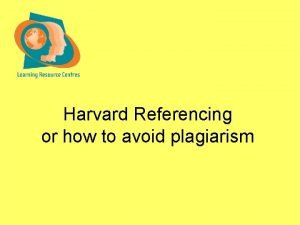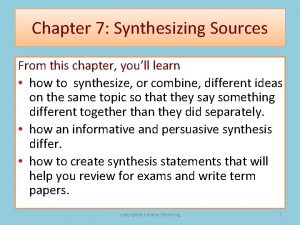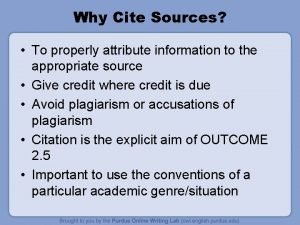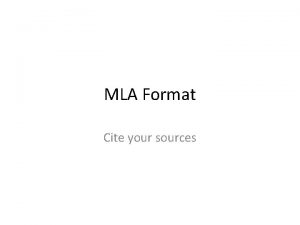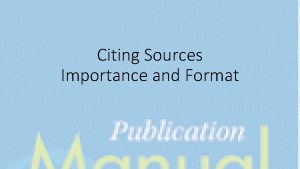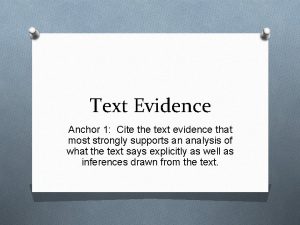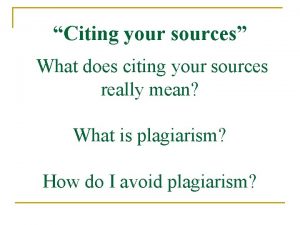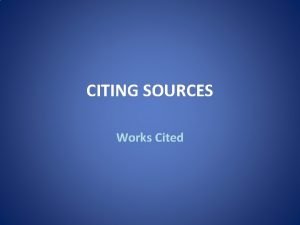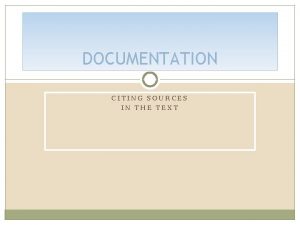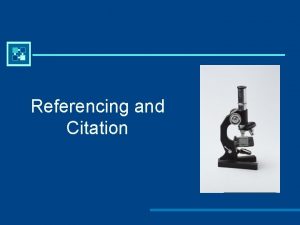Citing and Referencing Sources Referencing Other Peoples Work






- Slides: 6

Citing and Referencing Sources

Referencing Other People’s Work • citations are necessary to – give credit to the authors of the original idea or text – to put the idea in the context of the original work – to allow the reader to look up the original work and investigate it. citation – a reference to other work used as a source. Usually put in brackets and denotes an entry to the references section quotation – a direct repetition of a text in another document. Usually put in quotes or otherwise unambiguously visually delineated

Plagiarism • • • failure to cite appropriate sources is plagiarism. Specifically: use or close imitation of the language and thoughts of another author and the representation of them as one's own original work [Random House Compact Dictionary] ACM Code of Ethics gives the following examples of plagiarism: – verbatim copying, near-verbatim copying, or purposely paraphrasing portions of another author's paper; – copying elements of another author's paper, such as equations or illustrations that are not common knowledge, or copying or purposely paraphrasing sentences without citing the source; and – verbatim copying of portions of another author's paper with citing but not clearly differentiating what text has been copied (e. g. , not applying quotation marks correctly) and/or not citing the source correctly. Variations self-plagiarism: verbatim or near-verbatim reuse of significant portions of one's own copyrighted work without citing the original source [ACM code of ethics] – exception: publications based on previously copyrighted work (journal publication of conference proceedings) – require explicit citation but no quotation marks

Avoiding Plagiarism • it is tempting to use other people’s text, definitions, ideas – you read a lot of papers and try to extend other people’s work in your own research – certain things written by others would look so good in your paper/presentation/article. • make it a rule and to follow it strictly: if it is not yours – either cite or do not use. Several ethical and technical considerations – plagiarism irrevocably damages your academic career and name – once your work is published, it stays published indefinitely. There is no statute of limitations – search engines make it easy to find copied text

Practical Considerations • • if text, e. g. definition, is used by several authors without quotations: it is considered common knowledge: ok to use but still worth providing a citation. if presenting somebody else’s idea: retell or summarize rather than use their text. Do not forget to cite. do not reuse other people’s pictures in papers: draw your own. if using other people’s graphics in slides, make sure to cite – even though slides is not considered copyrighted work, still be careful with citations just providing reference without quotation marks may not be sufficient if it is artwork: ask permission, because it may be copyrighted in general err on the side of over-citing. If in doubt, consult somebody experienced

Avoiding Self-Plagiarism • • ACM is considering it an ethical violation as well requires extra effort to avoid: you are copying from yourself, you usually work on the same or similar things. practical rules: – technical report to conference or journal paper: okay to copy, no need for citation (techreport is not copyrighted). This might change with time – conference to journal paper: okay to copy, need citation – papers to thesis: okay to copy, need citation – slides: gray area, err on over-citing paper to paper? – if results/substance: do not copy – definitions: common knowledge – okay to copy, unless it is a key definition from another paper (substance). – introduction: grey area. However, try not to. Even if it may not be an explicit ethical violation, it looks bad. Instead, try rewriting an introduction from scratch, without looking at previous papers. It will significantly improve the paper, and make it look fresh.

